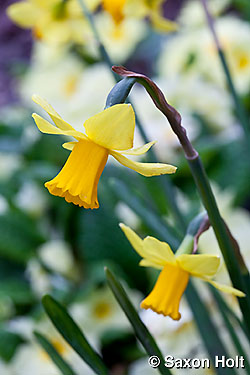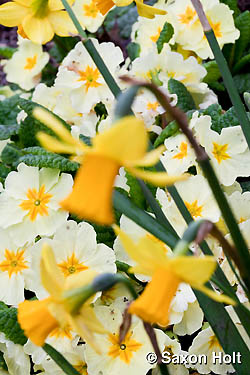What we see and what we capture with the camera are often different; too often if you are not careful to photograph with intent. What my mind’s eye sees when I enter my garden this time of year are yellow daffodils.
But actually there are only a very few.
In my mind’s eye I am seeing the thousands of other daffodils furthar on in the garden. The few by the driveway are just a tiny tease that get me excited to come home hungering to explore the garden for more. I would not want to reveal this as soon as I come in. I sorta like to be teased.
This time of year daffodils are the highlight of my garden. I have every class of Nacissi and every color. Tazetta do the best for me thank goodness, because their fragrance, along with the Jonquilla, make these my favorites.
The little one here with the swept back petals is a Cyclamineus variety ‘February Gold’ and I set out, with intent, to make a photo that said “yellow”. There is no getting around that yellow is what we think about with daffodils. Yes, there are wonderful white, and bi-color narcissus. There are ones with apricot, orange, and creamy trumpets but yellow is certainly what this daffy nut thinks about when I first visualize them in my mind’s eye.
I gave myself a photography challenge: make a photograph of my entry bed that said yellow and daffodils. I knew I was going to have to make the camera lie because, well, you see what it really looks like…
 To begin, I knew I would have to use a telephoto lens that would compress the key elements of my composition – the daffodils and the soft yellow primrose that I inherited with this garden; and which persist despite complete neglect. A wide angle lens reveals too much beyond so I set up my camera on the tripod looking slightly down on the daffodil hoping to fill the frame with primroses beyond.
To begin, I knew I would have to use a telephoto lens that would compress the key elements of my composition – the daffodils and the soft yellow primrose that I inherited with this garden; and which persist despite complete neglect. A wide angle lens reveals too much beyond so I set up my camera on the tripod looking slightly down on the daffodil hoping to fill the frame with primroses beyond.
The angle works; I can see the shape of the flower, its nodding head, its swept back petals. I have some nice lines – the stems dissect the frame and help aim the eye toward a focal point offset from center. A promising beginning, but nothing special and it certainly doesn’t say “yellow”.
 So I begin to pluck a few primula flowers to fill in the hole.
So I begin to pluck a few primula flowers to fill in the hole.
I find focusing back on the primroses gives me an accurate way to know just where my holes are. Notice I have already folded back a couple of distracting leaves from the lower left of the first composition.
As I build up the soft yellow color, relocating about 8 primrose flowers, I realize I need another daffodil in the lower left that will give the composition balance, balancing the range of yellows and the shape of daffodil flowers.
I cut one more ‘February Gold’, put it in a frog vase so that I can precisely place it in the frame:
Now when I re-focus forward on the top daffodil, the frame will tighten up and I can evaluate exactly where that third flower should be placed. I am also playing with my aperture and depth of field so that I get just the right amount of softness when I finish.
Keeping the camera on the tripod and not moving the camera angle during this process is obviously essential to this technique. I struggled a bit getting that third daffodil exactly where it did the most good. Rather than moving the camera a bit to tweak the composition, I moved the flower.
As you can see, I even tilted the flower a bit using a camera filter as a shim placed under the frog vase, to give that last flower the same lines as the others.
That last little piece, the soft orangey shape really finished the photo. Look back at the top of the page and notice how that third flower, in the lower left, really completes the composition.
Yes, the camera always lies, but my mind’s eye sees yellow daffodils and primroses when I enter my garden. Now I have a photo to match. Photograph with intention.



